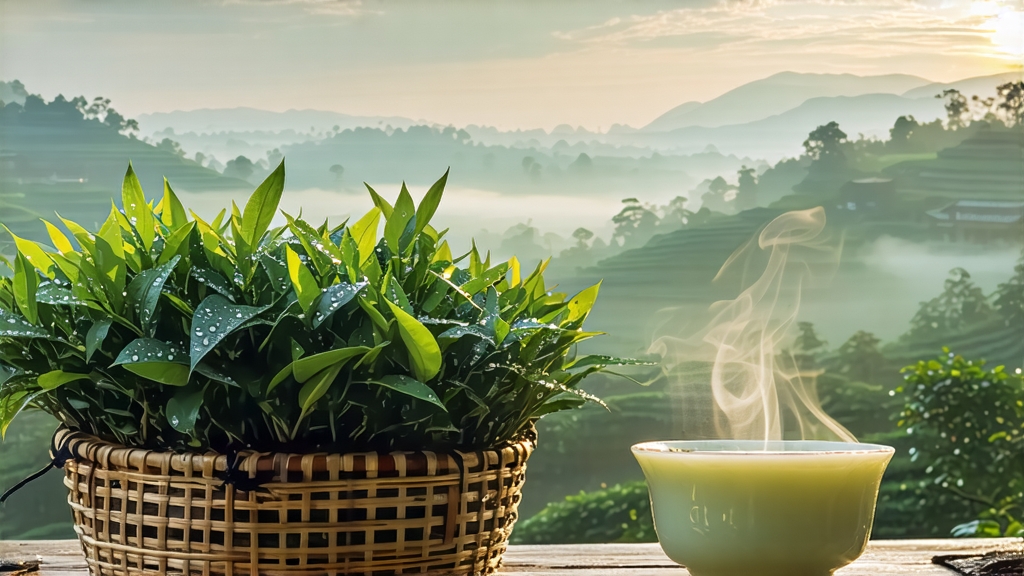
Alishan High-Mountain Oolong is not merely a tea; it is a liquid map of Taiwan’s central mountain range, a cup of drifting clouds and evergreen forests. Grown between 1,000 and 1,400 meters above sea level, this cultivar captures the island’s cool mist, diurnal temperature swings, and mineral-rich soils, translating them into an aroma that international drinkers often describe as “orchid in a pine breeze.”
History
Although Oolong technology arrived from Fujian in the mid-19th century, Alishan’s tea story truly began during the 1980s agrarian shift. Taiwanese farmers, seeking alternatives to lowland rice, migrated upslope and discovered that the native Qingxin (Green Heart) cultivar, when planted in volcanic loam under constant fog, produced a greener, more floral style than its mainland ancestors. Government agricultural stations provided micro-financing and vacuum-packaging machines, propelling Alishan into the global spotlight just as the gourmet tea renaissance dawned in Tokyo, Paris, and San Francisco.
Terroir & Harvest Calendar
The Tropic of Cancer slices through Taiwan, granting Alishan a unique “eternal spring” climate. Morning clouds act as a natural shade cloth, slowing photosynthesis and increasing amino acids such as L-theanine, which creates the tea’s signature milky sweetness. Day-night temperature differentials can exceed 15 °C, thickening leaf cell walls and concentrating aromatic oils. Only three flushes are plucked yearly: spring (late March to early May), summer (June, often skipped to let plants rest), and winter (mid-October to November). Connoisseurs prize spring for its layered fragrance and winter for its crisp, stone-fruit finish.
Plucking Standard
The mountain rule is “one bud, three leaves” picked when the dew has lifted but before the sun turns fierce. Pickers wear bamboo hats and hemp satchels, twisting each shoot rather than snapping it to keep the cambium intact. A skilled worker gathers barely eight kilograms of fresh leaf in a day—just enough, after processing, for one kilogram of finished tea.
Crafting the Leaf: Eight Stages
- Solar Withering: Leaves are spread on bamboo trays under filtered sunlight for 20–30 minutes, initiating enzymatic oxidation.
- Indoor Withering: Trays rest on racks in a climate-controlled room where electric fans simulate the mountain wind. This “quiet breathing” lasts 6–8 hours, reducing moisture to 60 %.
- Bruising & Tossing: The leaves are tumble-turned in a waist-high bamboo drum for five minutes, cracking cell edges to invite partial oxidation (15–25 %, greener than Dong Ding but higher than Baozhong).
- Oxidation Pause: A 90-minute rest allows floral compounds such as geraniol and linalool to bloom. Masters sniff the leaf pile every fifteen minutes, waiting for the exact moment when green notes fade and white peach emerges.
- Pan-Fixation: A 260 °C wok arrests oxidation within two minutes, locking in the jade-green center while edges turn ochre.
- Rolling & Balling: The warm leaves are wrapped in cotton cloth and rolled under mechanical pressure into tight hemispheres. This step is repeated 30–40 times over two hours, forcing residual sap to the surface where it will later caramelize during roasting.
- Light Charcoal Bake: Using longan-wood charcoal embers, the tea is baked at 80 °C for four hours, then rested for a week. The cycle is repeated twice more, deepening sweetness without adding smoke.
- Sorting & Stem Picking: Women seated around low bamboo tables hand-pick stems and yellow leaves, ensuring uniform jade pellets that will unfurl like miniature bouquets in the gaiwan.
Grades & Styles
- Alishan Qingxin Oolong: the classic, lightly oxidized, 20 % roast.
- Alishan Milk Oolong: a modern “naked” style, zero roast, vacuum-sealed immediately after rolling to preserve a natural lactone creaminess—no flavor additives.
- Heavy-Roast Alishan: favored by traditionalists, 40 % oxidation and 12-hour charcoal finish yielding cocoa and toasted almond notes.
- GABA Alishan: nitrogen-flush oxidation increases gamma-aminobutyric acid, marketed for relaxation.
Water & Vessel Philosophy
High-mountain ool